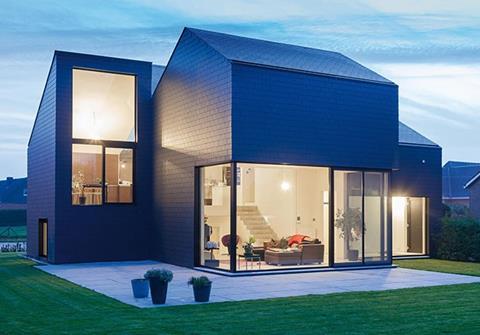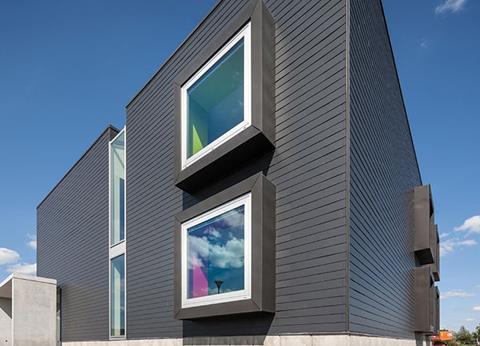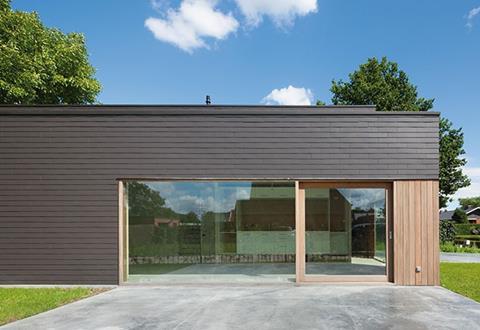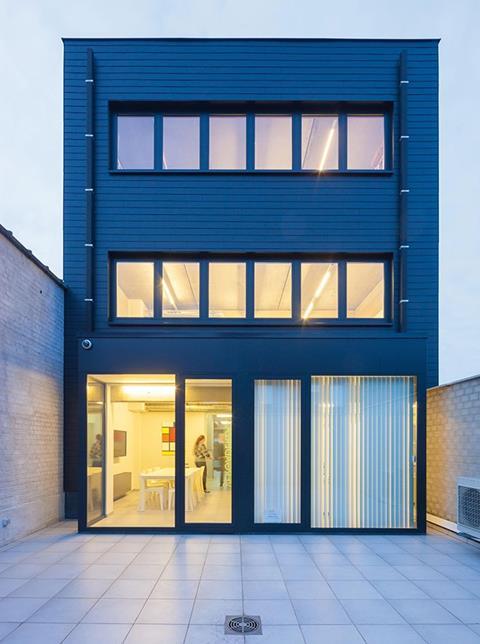Fibre cement is a strong, durable material used in a number of internal and external construction applications. Our latest CPD module, sponsored by Marley Eternit, will examine the use of fibre cement slates for cladding

How to take this module
UBM’s CPD distance-learning programme is open to anyone seeking to develop their knowledge and skills. Each module also offers members of professional institutions an opportunity to earn between 30 and 90 minutes of credits towards their annual CPD requirement.
This article is accredited by the CPD Certification Service. To earn CPD credits, read the article and then click the link below to complete your details and answer the questions. You will receive your results instantly, and if all the questions are correctly answered, you will be able to download your CPD certificate straight away.
CPD CREDITS: 60 MINUTES
DEADLINE: 17 OCTOBER 2014
![]()
INTRODUCTION TO FIBRE CEMENT SLATES
Fibre cement is a strong, durable material used in a number of internal and external construction applications, including internal lining, cladding and roofing.
The manufacturing process was invented in the 1890s by an Austrian, Ludwig Hatschek. He mixed 90% cement and 10% naturally occurring fibres with water and ran it through a cardboard machine, forming a sheet material that could be used for siding in housing. Modern production still uses the Hatschek process but uses modern reinforcement fibres. Today’s cement fibre panels comprise cement, cellulose (from wood fibres), textile fibres, water, air and selected additives.
The material’s multi-layered fibre structure supports the cement and other solids, which gives it impressive strength, and means that it can be far thinner than concrete. It is also far more malleable than comparable natural products, which means it can be easily cut into tiles. These characteristics have allowed manufacturers to develop products that offer an alternative to natural slate in roofing and cladding applications. Such fibre cement “slates” are increasingly common in both new-build developments and refurbishments.
This CPD will examine the use of fibre cement slates for cladding, including their manufacture, performance benefits as tested against relevant British and European standards and sustainability credentials.

MANUFACTURE OF FIBRE CEMENT SLATES
The production process for fibre cement begins by mixing cellulose and man-made fillers and fibres with water, and then adding cement. The mixture is then formed into wet sheets and rolled on a conveyor. The sheets are pressed and water is extracted.
Immediately after it is formed, fibre cement is still pliable. It can therefore be shaped into small slates, large panels or corrugated sheets. For slates, the finish can be left smooth or riven for a natural effect.
After drying, sheets can be left in their natural tone or coloured using water-based coatings. Fibre cement slates are therefore available in a number of different shades. Other coatings are also applied at this point in the production process: a primer, a UV-resistant acrylic coating and a clear wax to the underside of the slate.
CLADDING APPLICATIONS FOR FIBRE CEMENT SLATES
Fibre cement slates can be used as a cladding material on both new-build and refurbishment projects, to provide a protective, continuous building envelope. On existing buildings, fibre cement slates can correct any irregularities in walls and allow insulation to be added without impacting on the interior surface of the building or causing disruption to the occupants.
Fibre cement slate cladding systems are suitable for use on masonry panels and walls made of brick and blockwork, precast concrete walls and timberframe structures. When fibre cement slates are used in cladding applications, the backing structure must be the wind- and waterproof construction. The Vertigo cladding range from Marley Eternit is suitable for use with windloads of up to 2.0kN/m2.
When fibre cement slates are used in cladding rather than roofing applications, the main difference is the way they are fixed. For cladding applications, vertical timber battens are attached to the wall with galvanised steel brackets, which can be adjusted to suit the thickness of the insulation required.
The next step is determined by the chosen pattern. There are three main options: traditional, broken bond and panel.
- Traditional This uses nail-holed slates and has a staggered pattern with slates fixed vertically with hooks. No drilling is required.
- Broken bond Here, the slates are staggered and overlap horizontally, giving a close boarded effect. The slates are pre-holed and attached with jagged copper nails. In both traditional and broken-bond installation, horizontal timber battens are attached on top of the vertical battens with screws, and the slates then attached to the horizontal battens.
- Panel This is a geometrically precise pattern with the slates aligned both horizontally and vertically and a horizontal overlap. If using this method of installation, a 90mm-wide “double lip” waterproof strip is applied to the vertical battens and the pre-holed slates nailed or screwfixed directly on top.
In addition to the thickness required for insulation, the positioning of the vertical joists should allow for a continuous air gap of a minimum width of 20mm along the whole height of the vertical wall. The top edge of the facade is protected by the installation of a separate capping piece to form a drip-edge. The bottom is protected by a ventilation grill that prevents rodents from entering.

ADVANTAGES OF FIBRE CEMENT SLATES
The cellulose and cement-based structure of fibre cement slates brings a number of performance benefits these include:
Strength Tests carried out to the requirements of BS EN 492: 2012 “Fibre cement Slates and Fittings” indicate that a 4mm-thick fibre cement slate will have an average bending moment greater than 50Nm/m (Class B).
Weight Fibre cement slates also weigh less than many comparable products. When tested to BS EN 492, a 4mm-thick slate was shown to have a minimum apparent density of 1700kg/m3. In comparison, natural Welsh slate has a nominal density 2840kg/m3. The lightness of fibre cement slates also brings a number of sustainability benefits (see below).
Thermal efficiency Cement fibre has low thermal conductivity, which means that it can aid compliance with the requirements of Part L of the Building Regulations. The 2013 update to Part L includes a notional dwelling with a target thermal transmittance, or U-value, for external walls of 0.18W/m2K. The thermal resistance, or R-value, of fibre cement slates when dry is 0.011W/m2K, which allows for greater flexibility in the thermal performance of other aspects of the fabric. Should higher levels of thermal resistance be required, the cladding fixing system can be adjusted to allow thicker insulation to be used.
Moisture resistance Fibre cement is a highly water-resistant material. Slates must be tested for resistance to wind-driven rain and meet the requirements of BS 5534:2003 Code of Practice for Slating and Tiling. Water absorption of slates is around 18%. The growth of mosses and lichens may occur over time, but does not adversely affect their performance. Cladding systems must also be moisture-resistant from the inside, which means that a gap for ventilation is required. This should have a minimum width of 20mm along the whole height of the vertical wall.

Resistance to decay Although fibre cement contains wood, because it is bound by inorganic cement it is not susceptible to damage from mould or rot. As it contains no metals, it will not rust.
Fire resistance Because the wood-fibre content of slates is protected by cement, they have excellent fire-resistance properties. There are no restrictions on their use under Building Regulations and they are classified as class A2 S1 d0 under BS EN 13501-1:2007+A1:2009, Fire classification of construction products and building elements.
Heat resistance After an initial period of stabilisation, slates are normally unaffected by the range of climatic temperatures (-20°C to +70°C). However, they should be laid with a gap of 5mm to accommodate any movement induced by changes in temperature.
Frost resistance Fibre cement is unaffected by frost. The frost-resistance requirements for slates are set out in BS EN 492.
Colour stability The acrylic coating used on the slate surface has good colour stability proven over long periods of exposure to UV and sunlight. Some lightening may occur over a period of exposure to sunlight and normal weathering, which may affect the surface coating. This gradual lightening is similar to that experienced with natural slate.
Resistance to atmospheric pollution Fibre cement slates are suitable for most rural, marine and normal industrial environments. Discharge of gases or liquids from chemical processes onto the surface of the slates should be avoided. They are resistant to all but the most highly polluted atmospheres where sulphur dioxide levels exceed 70µg/m3 of air.
Resistance to wildlife Slates are not affected or degraded by birds, rodents or insects.

SUSTAINABILITY AND FIBRE CEMENT SLATES
One of the reasons that alternatives to natural slate are needed is because it is a finite resource subjected to energy-intensive quarrying. In some respects fibre cement slates face similar challenges: they too require the energy-intensive extraction and treatment of raw minerals in the production of cement. However, they do offer a number of sustainability benefits when considered over their whole lifecycle.
Renewable and reusable materials Cellulose fibres can be drawn from renewable sources, as well as from waste products such as saw dust. Ranges of fibre cement slates have been certified as “very good” under the BES 6001: Responsible Sourcing rating system.
Manufacturing process No hazardous materials are added during manufacture. The process is relatively short and the product is air-cured, which means that the energy consumed is less than for many comparable products.
Energy saving The slates’ high level of thermal resistance means that they can play a key part in a low-energy strategy. Fibre cement cladding boards can be used to achieve an A+ rated facade according to the BRE Green Products Guide.
Lightweight The external envelope of a three-bedroom house can weigh as much as 90,000kg using traditional construction materials. With the use of modern materials, including fibre cement, this can be reduced to about 10,000kg. The use of fibre cement can therefore offer considerable savings on the energy and cost involved in transporting materials.
Durability Tests by the BRE have indicated that fibre cement slates have a service life of more than 60 years. Energy is therefore saved because replacement products are not required.
Recyclability At the end of their life, crushed fibre cement products can be recycled without need for further processing, as a raw material for use in Portland clinker.
It has been calculated by the Carbon Trust that fibre cement slates have a low carbon footprint of 13CO2e/m2.


How to take this module
UBM’s CPD distance-learning programme is open to anyone seeking to develop their knowledge and skills. Each module also offers members of professional institutions an opportunity to earn between 30 and 90 minutes of credits towards their annual CPD requirement.
This article is accredited by the CPD Certification Service. To earn CPD credits, read the article and then click the link below to complete your details and answer the questions. You will receive your results instantly, and if all the questions are correctly answered, you will be able to download your CPD certificate straight away.
CPD CREDITS: 60 MINUTES
DEADLINE: 17 OCTOBER 2014
Privacy policy
Information you supply to UBM Information Ltd may be used for publication and also to provide you with information about our products or services in the form of direct marketing by email, telephone, fax or post. Information may also be made available to third parties. UBM Information Ltd may send updates about Building CPD and other relevant UBM products and services. By providing your email address you consent to being contacted by email by UBM Information Ltd or other third parties. If at any time you no longer wish to receive anything from UBM Information Ltd or to have your data made available to third parties, contact the Data Protection Coordinator, UBM Information Ltd, FREEPOST LON 15637, Tonbridge, TN9 1BR, Freephone 0800 279 0357 or email ubmidpa@ubm.com. View our full privacy policy at www.building.co.uk/cpd

















No comments yet